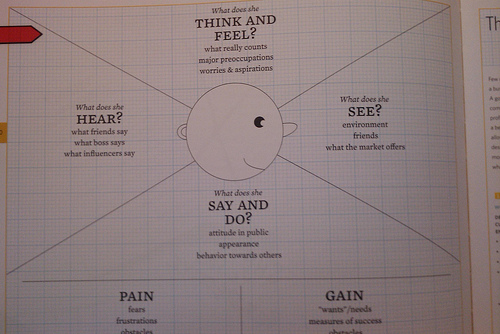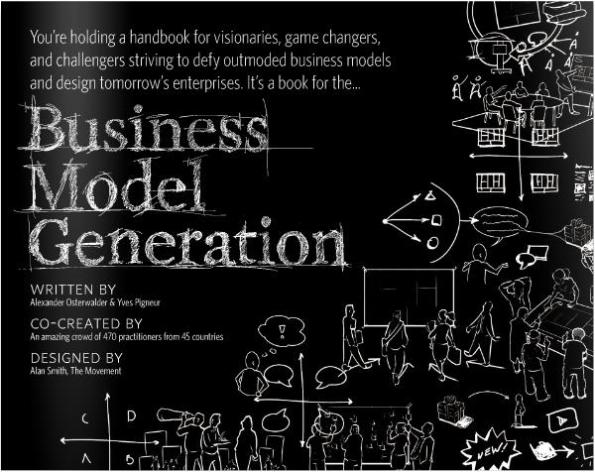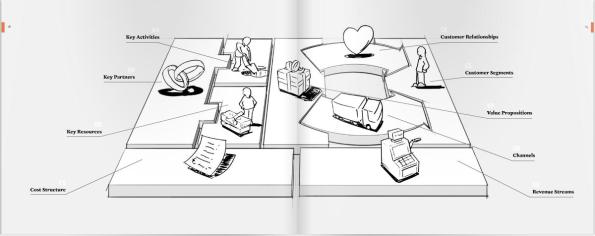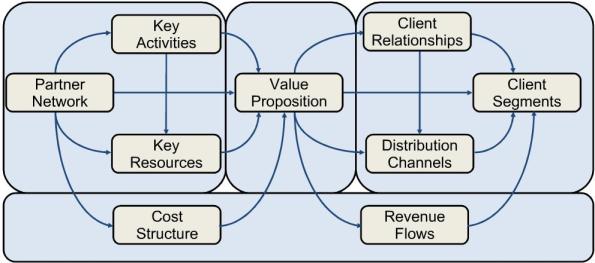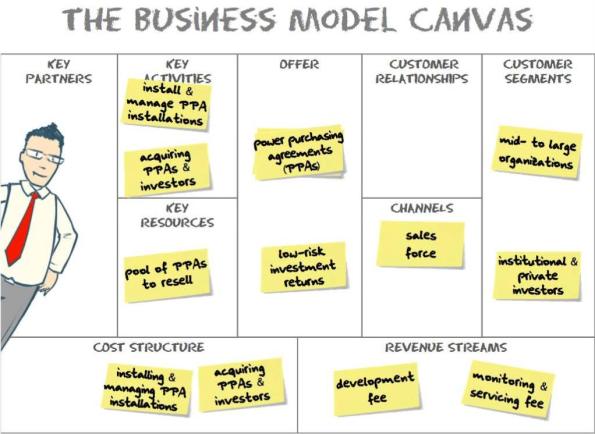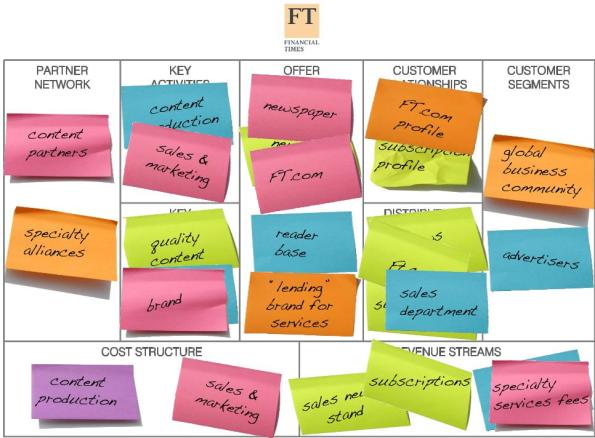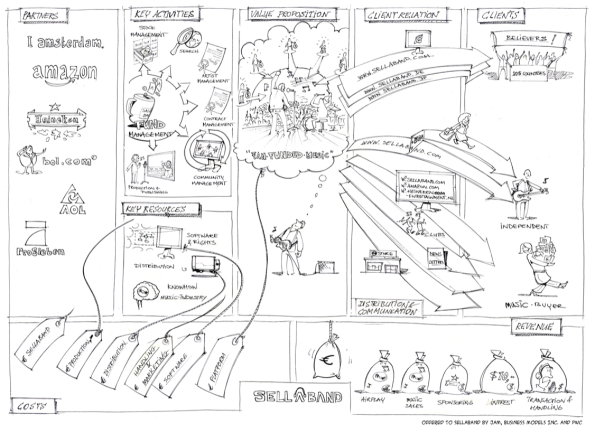Archive
Ellen Levy on pulling resources together to solve difficult problems
A very nice talk from Ellen Levy – VP of Strategic Initiatives at LinkedIn – at the Business Innovation Factory’s Collaborative Innovation Summit in 2007 on pulling resources together to solve tough problems. Levy talks about her experience as Director of Industry Collaboration and Research for MediaX at Stanford University. In her role, Levy wired together companies wanting to solve tough problems with interdisciplinary faculty members at the Stanford.
Anyway, here’s the talk.
glenn
Social Media for Business Innovation at The Guardian
Very nice presentation from Mike Bracken of The Guardian at the Gartner 2010 Symposium on leveraging social media for business and organizational innovation.
Bracken starts speaking at approx 5:15 in the video, and a brief cheesy musical clip follows, but the rest of the presentation is excellent. Presentation slides can be viewed here. I’ll have more to say on this video shortly.
glenn
Enterprise 2.0, SOA, and the Cloud – Dion Hinchcliffe connects the dots at OSCON 2010
I’ve been a fan of Dion Hinchcliffe for many years. Hinchcliffe operates at the intersection between social, web-based business strategies and web/service-based application architectures – and is a brilliant visual thinker to boot!
In March 2010, Hinchcliffe delivered a very insightful presentation on Social Business Strategies and open business models at the Social Business Summit. I recently came across another presentation that Dion gave in July 2010 at O’Reilly’s OSCON 2010 on the interesection between service-oriented/web-oriented archtiectures, social business strategies, and cloud-based business models. The presentation can be viewed below:
The slides for the presentation can be downloaded here.
In the presentation, Hinchcliffe discusses the role that new Service and Web-based application architectures, deployed in the cloud, play in enabling radically different business models. As a result, the talk is both more technical than the presentation Dion gave at the Social Business Summit, and more ambitious in scope.
In this blog post, I’m going to summarize the takeaways from Hinchcliffe’s presentation that I found most interesting.
Converging models of Open Computing
Hinchcliffe begins the presentation talking about 3 key convergent models of Open Computing: Cloud Computing, Social Business (or Enterprise 2.0), and Service-Oriented Architecture, as communicated in the slide below:
The pervasive theme here is that of open models of collaboration and interaction, fundamentally enabled by the global reach and ubiquitousness of the Internet.
Change is Pervasive in Business and IT – it’s open and it’s social
The following slide speaks for itself:
Change is pervasive in both business and IT today – it’s open, it’s social, and it permeates every aspect of the business from customer service to product development.
Service-Oriented Architecture and Web-Oriented Architecture
I’m going to show numerous visuals from Hinchcliffe’s presentation, all of which originally appeared in previous Hinchcliffe blog posts. I really can’t say enough about how masterful Dion is in conveying complex topics visually.
Next, Hinchcliffe explores the importance of SOA – or Service Oriented Architecture – as a foundation for enabling this new world of open computing on the Web. He notes that SOA emerged in part as an architectural paradigm for integrating disparate application siloes across the enterprise and between enterprises, as well as for designing software solutions “in the very large” – for designing systems of systems of systems.
Services are the most recent paradigm for how applications expose their functionality, as illustrated by the slide below on the history of software:
And while the original vision for connecting services was promoted under the term SOA, it was really the Web that showed us the “true path” towards service-orientation, which Hinchcliffe refers to as Web-Oriented Architecture (or WOA). And while the underlying principles are very much in accordance with SOA design principles, the implementation specifics of WOA are what make it unique. More on WOA later in this post.
The business case for SOA in the Cloud
Increasing, however, SOA-based implementations are found not behind the walls of the enterprise firewall, but in the Cloud. And the reason is that emerging business models – that massively leverage network effects – are built offering cloud-based services. The visual below shows that Amazon now uses more of its IT infrastructure to provide cloud based services to external applications than to services its customers through its website.
Says Hinchcliffe:
We’ve been focusing on applications and point-solutions – especially in enterprises – for a long time. We’re trying to solve a specific problem. Whereas on the Web and in the Cloud, we’ve long since moved beyond apps, and we think primarily about platforms. That’s where the big value is or the order of magnitude, or perhaps several orders of magnitude, comes from …
The network effect is substantially higher when we build a platform that says, “No, we’re not going to be in a single place or a few points of light on the Web. We’re going to be on 50,000 – or in Amazon’s case over 300,000 – different other places. Our supply chain, our Cloud, will be integrated into everything, and we get value out of every piece of that flow.” This is the new economic picture for Software, for Services, for the Internet.
Service-Oriented Architectures enable new Business Models
Hinchcliffe continues:
So the strategic goal of SOA, at the highest level, was turning applications into platforms. That’s what we learned 5 years ago with Web 2.0: A platform beats an application every time.
… It’s a new digital business model. And this is the hardest part we see with traditional organizations that look at there business in a very 20th-century way. It’s not paving the cow path. It’s not rewriting the brochure onto your website. It’s about creating fundamentally new businesses based on the capabilities that you have – what data and what services you have.
For more on SOA (or Services) as a platform for new business models, please see:
Clouds as a platform for new Business Models
Then Dion gets to the absolute heart of the matter:
So one of the questions I like to post is “How do we best think about our Clouds?” Is it about the Services and the Data? Or is it about the Business Models around it?
This question is illustrated in the slide below:
Hinchcliffe continues:
If you look at a World Bank, Best Buy – these are very traditional organizations. They now have full-blown developer networks in scale. Many other traditional organizations do too. And this is one way of really thinking about this, is we see the developer network wrapped around traditional businesses. It looks strange to us, even if we’re inside the industry. But this is really what we’re seeing. This is how we turn our businesses into platforms. This is the new Cloud.
On the value businesses derive from providing Cloud-based services, Dion comments:
It’s not from the first use of that Cloud API [that the value comes], it’s from the hundred or thousand reuses from all the partners you may have. Whether that’s a horizontal cloud service like Storage, or a vertical service like Credit Card Processing. Your job is to drive unintended uses, and make it as easily consumable as possible.
Of course, that’s what we wanted in SOA. But it’s actually what we achieved on the Web. The Web has been a runaway success. Every major Web product has an API and a developer network. This is how you distribute in the Cloud today.
But the focus was different. [SOA] was much more about creating Services, and the other one [Web 2.0 Services] was about driving consumption – how do we make sure what we have in that service is the best, the most valuable. Because in an era where the world is flat, people can vote with their feet, with a URL and plug-in a new API.
Interesting stuff.
So what happened to SOA?
So what happened to SOA? Hinchcliffe’s view is that we are actually seeing very low rates of adoption amongst enterprises – to the tune of low-high single digits. This is due to several reasons, including:
- Failing to drive the business conversation – SOA was good at connecting stuff together, but it didn’t really drive conversation around re-architecting the way we do business digitally
- The technical approach seemed to have the wrong focus, and Web 2.0 organizations found better architectural approaches (i.e. Web-Oriented Architecture)
The contrasting approach of SOA and WOA to application architecture is illustrated in the visual below:
I’m not going to elaborate on the differences between SOA and WOA in this post, but Hinchcliffe does add that most Websites and Cloud Computing platforms today use designed around Web-Oriented Architectures (including using REST-based APIs).
Here’s another visual from Hinchcliffe’s presentation that illustrates key principles/components of a Web-Oriented Architecture:
Quoting Hinchcliffe:
That’s really what we’ve learned, that Services and Data work much better when they align naturally with the grain of the web. … All of our data, and the entire data model, is nothing but links and pages if you will, Linked Data of course.
For additional insight into Web-Oriented Architecture and its relationship to SOA, please see the following Hinchcliffe articles:
- The SOA with reach: Web-Oriented Architecture – April 2006
- What Is WOA? It’s The Future of Service-Oriented Architecture (SOA) – February 2008
- 12 Things You Should Know About REST and WOA – April 2008
- The SOA world begins considering Web-Oriented Architecture (WOA) in earnest – September 2008
- Unboxing Web-Oriented Architecture: The 6 Aspects Of An Emergent Architectural Style – June 2009
- Where Is The Future of SOA Headed? Where The Web Goes… – September 2009
- A Web-Oriented Architecture (WOA) Un-Manifesto – December 2009
The Cloud IS our Global SOA
So what we’ve learned, says Hinchcliffe, is that the Cloud IS our global SOA. There’s a full spectrum of what we’d call Services – anything that’s pullable from HTTP is a cloud service, like it or not. Even a web page is a cloud service.
Dion elaborates:
But that unstructured information and HTML isn’t necessarily where the interesting part is – although entire businesses have been formed around making sense of that, like Google.
It’s the Services head that is particularly interesting to us – where the Web APIs are. … And we’re now seeing brand new emerging models for distributing services, and I’ll talk about that as we finish. … But we’re now understanding that everything that we can pull via HTTP are part of the Cloud.
Enterprise Data in the Cloud
So all these ideas are allowing us to create our own Clouds.
Quoting Hinchcliffe again from the presentation:
Open APIs and Web-Oriented Architecture have informed the best approach to SOA, that battle seems to have finally been won. And Cloud Computing, that’s standard. Everything I just said, that’s generally how we do Cloud Computing.
But there’s a new scenario – and that’s where we start to talk about the other threads in our conversation – that is creeping into our organization, and that’s data explosion. … And given that the visual web is soon going to be eclipsed by the non-visual, Services “cloudy” Web – if it hasn’t already for most of us, in fact – we’re going to have this same issue, because we’re creating this whole microcosym within our organizations in the Enterprise Data Cloud. And this is really the challenge of what we call Enterprise 2.0.
For more on enterprise data in the cloud, please see the following Hinchcliffe article from February 2010: The Enterprise Data Cloud: Why Information Power Is The Future of Business.
Enterprise 2.0
Next, Hinchcliffe moves onto the topic of Enterprise 2.0 – or social media and collaboration within the Enterprise based on Web 2.0 technologies.
However, Dion provides a very interesting technical definition of Enterprise 2.0 in the slide above: The application of user generated Web technologies to create a WOA data ecosystem. This definition very much builds on the Enterprise Data Cloud notion that Hichcliffe discusses in the previous slide. He goes onto elaborate:
Open communication, Shared knowledge – making sure anyone can participate – that’s very important, fundamentally web-oriented, and emergent and free-form. Those last two pieces are very, very important.
On the pace of technological change and its impact on the enterprise, Hinchcliffe has this to say:
Right now technology is accelerating away from the rate of change in the business world. There’s this growing gap, and I don’t know what’s going to happen. This is what all the books are [talking about these days]: What are we going to do about this growing gap? Centralized, bureaucratic organizations can’t keep up with the pace of innovation out there. What’s going to happen? Is there going to be some dislocation or disruption? We don’t know what’s going to happen, but it’s going to be interesting to watch for sure.
The Social Web
Says Hinchcliffe:
The Social Web now is the dominant model for communication, except maybe text messages. … The number of global users of social communication has eclipsed e-mail. The key point here is that e-mail is not based on the architecture of the World Wide Web, but most of the Social Web is. So you look at communications going fundamentally web-oriented – in terms of link structure and how the data’s connected, and how we locate it and parse through it, all the APIs that access it; all that is in now a format that aligns with where the cloud is going, and is what we’re going to be using in terms of communication in the future. This is just the beginning of the trend, and most organizations aren’t ready for this.
The future of Enterprise 2.0
Where we’re headed, according to Hinchcliffe, is towards what he terms a peer-produced Intranet – this healthy web-based ecosystem. Where we can use the applications of our own choice, to create the data and applications we need, and be competitive and connected to the greater cloud as well. And do this alongside traditional enterprise systems that are running the business today.
The Big Picture – Social Business
Hinchcliffe does a quick call-out to the emerging category of Social Business.
Social Business is not the topic of this talk, so Hinchcliffe only lightly touches on the topic. For a full treatment of the topic, please see Hinchcliffe’s presentation at the Social Business Summit 2010.
The IT Department’s view of Enterprise 2.0
So how do IT departments have to adapt to an enterprise 2.0 world? Says Hichchliffe:
Your IT department and your organization is going to look at things much more monolithically. They’re not ready to have this highly web-oriented, every piece of data has an address, every service has a URL, every endpoint is all based on these technologies, and it’s a relatively simple and flat structure where everything is available. I can even find data via my search engine, I can find data via my search engine, if I know where to look for them.
Unfortunately our enterprises are far too complex for that. This is all the typical high-level moving parts in a modern enterprise around data.
Continues Hinchcliffe:
You have the archiving, and the auditing, and the search, and the visualization, and the business intelligence … And we’ve got to somehow break away from that. We need governance and security, but the world we’re moving into right now is going to be much, much more federated. The applications of the web already do that today, and those same models are moving into the enterprise.
For a very nice analysis of the importance of data-centricity for today’s businesses, please see Eight Reasons Why Data-Centricity Is The Future Of Business.
The Enterprise is not the Web
Hinchcliffe:
But we’re going to have to help our organizations understand that. That’s going to be one of the biggest roles of education, because the enterprise isn’t the web.
The following graphic illustrates some of the key difference of Web-oriented architectures applied to the Web vs. the Enterprise:
We want to replicate the successful aspects of the large cloud – that’s the dominant IT system in the world today. But we have to figure out how to adapt and how to augment our systems.
Lack of visibility into Enterprise Data – a key challenge
Hinchcliffe:
But the real issue is going to be this – and we see this issue talking to Jive software. They find that customers that have had these types of tools deployed throughout the organization for a couple of years are encountering this exact progression we see here, where you have this information exposure. Suddenly what everyone is doing, and all the data people have and all the projects and documents, and all the information and apps that they’re using, are suddenly visibile within the organization.
And they’re like “Wow, how am I going to deal with this?” And it’s like Clay Shirky said, it’s not information overload that’s the problem, we want the information. It’s filter failure.
Most of the vast repositories of data in enterprises – something like 80%, 90% in some organizations like government – is just not accessible in any practicle manner. Yet we pay a fortune to keep it around, and use it once in certain applications as opposed to making real use of it – the way we do on the Web – which is to get it out there to everyone who needs it.
Enterprise 2.0 is changing that.
Continuing:
Web and web-oriented based cloud infrastructure will create this visable surface area. And we have this explosion I have there on the diagram. The next phase is going to be “OK, how do we deal with it.” All the silos are actually being torn down. Finally. These tools naturally do that – they link everything together, they connect everything together.
All your services can be easily connected together. A little bit of glue in your favorite scripting language can pull together systems around the world – I do demos all the time for web-oriented APIs build amazingly powerful applications using Rails in a few minutes, using APIs from all over the place. That’s just how the world works now.
But that visible surface area causes a huge management issue. Who’s going to adminster that? That’s what I hear- the IT department says “Who’s going to support that?” We don’t have the answer to that, but the answers probably not how we do things today.
For more on enterprise approaches to Open Data, please see The future of enterprise data in a radically open and Web-based world.
Enterprise Mashups – an emergent trend
Hinchcliffe:
One emergent solution is Mashups. We’ve been talking about that for 5-6 years. The Web’s been doing this for a long time. But they’re just now starting to get into businesses in a real way.
End-user Empowerment – DIY Computing in the Enterprise
Hinchcliffe:
But it’s really about saying, well, in any organization there’s maybe about a few hundred developers, and there’s maybe a few thousand IT people, and maybe 5, 10, or 100 thousand of everyone else. … Where’s the productive capacity? Where are the ideas coming from? Well they’re going to come from that whole spectrum. So that’s where the idea of participation comes in. Authorship needs to be in everyone’s hands.
… These very free-form and emergent social platforms are natural integration points. Cut-and-paste integration goes away. You’re actually using these social tools to knit together things. … Putting authorship ability in everyone’s hands to keep the cloud tidy and neat and organized really works, because it works in a much bigger example we all use every day.
… Civilization advances when things that were hard are made simple. And this is what Cloud technologies are doing, they’re making things that were formerly very hard much simpler.
Enterprise App stores
Hinchcliffe:
So the Mashup story is very exciting – we’re seeing it go into the enterprise now. But what’s really exciting – the latest trend, to wrap this session up – is App Stores.
Hinchcliffe goes on to briefly discuss App Stores in the enterprise, but I’m going to wrap up the post here.
In Summary …
A wonderful presentation from Dion Hinchcliffe that ties together disparate threads of Service/Web-Oriented Architecture, Social technologies in the Enterprise (aka Web 2.0), and Cloud Computing.
glenn
Bill Moggridge on Design and Business Innovation
Bill Moggridge and Interaction Design
Bill Moggridge is a bit of a legend in the Design world, having co-founded IDEO, and authored the wonderful book Designing Interactions. I recently watched a video of a presentation that Moggridge gave at Stanford in 2007 on this book, which can be viewed below:
Design’s role in a Business Innovation
Like many folks in the Design world these days (see here and here), Moggridge also speaks of Design in the context of Business Design. In the slide deck from his recent presentation, Moggridge presents an interesting model/framework for business innovation, which is shown below:
I really like this simple visual, which positions Business Innovation at the intersection of Business, Design, and Technology.
Business Architecture – another view of the intersection of Business and Technology
This diagram reminded me a lot of another diagram which shows the confluence of three disciplines that span business and technology. The diagram below is from an IBM whitepaper, which positions Business Architecture at the intersection of 3 key core enterprise disciplines – Strategic Planning, Business Execution (or operationalizing Business Strategy), and IT:
Like Moggridge’s Business Innovation framework, this visual crucially positions Business and Technology as overlapping concerns – from both a strategic and operational vantage point. But unlike Moggridge’s framework, it leaves out Design as a strategic consideration in and over-arching Business Design framework. Increasingly, I think this will prove to be an important omission.
Bill Buxton would concur
In a recent post where I provided a link to a Bill Buxton lecture at Stanford in 2007, I had commented:
Buxton says he’s working more these days to help Microsoft redesign its organization and processes that on product design.
Secondly, and this is very fascinating to me, Microsoft is developing an approach to business innovation and product development it calls BXT – Business eXperience Technology. That is, Microsoft feels it needs to bring business thinkers and doers, technology thinkers and doers, and design thinkers and doers, and have them work together in a cohesive fashion around business innovation and product development. Buxton talks a bit about this approach in a piece he wrote for Business Week in 2009.
Here again we see Buxton and Microsoft treating the intersection of business, design, and technology as strategic to business innovation.
I think Moggridge and Buxton are definitely onto something here.
glenn
Developing deep insight into your Customers – XPLANE’s Empathy Maps
OK, more thoughts on Alexander Osterwalder‘s new book Business Model Generation – see my previous related blog posts here and here.
The topic of this post is an innovative technique for developing a “deep” understanding of your customers – their environment, behavior, concerns, and aspirations – called the Empathy Map. The Empathy Map is presented by Osterwalder in his book, but was originally developed by Dave Gray at XPLANE .
Introducing the Empathy Map
Here’s a snapshot of what the Empathy Map looks like:
The Empathy Map is both a framework and a technique, and it’s typically developed collaboratively by a diverse team by placing sticky notes on a wall. If you’d like to download a template of this poster, you can do so here.
Developing a deeper understanding of your customers by understanding:
- Who they are in their world
- Where they spend their time
- Who their friends are
- Whose opinions influence them
- What they SAY their deepest aspirations and beliefs are
- What feelings and beliefs ACTUALLY guide their behavior
You get the idea. Also, pay special attention to potential conflicts between what a customer might say, and what they may truly think or feel.
Empathy Map in Action
The image below is an example Empathy Map taken from the Business Model Generation book that models the customer profile of a CIO.
The motivation, in this instance, for creating the CIO profile is to understand the key factors that weigh on their decision to renew Microsoft Office product licensing agreements.
The details are not so important, and they’re a bit hard to read, but the important points are:
- The value of formally modelling a customer’s beliefs and motivations in their world
- To assemble a diverse group of stakeholders to develop this profile of the customer
- And to use this profile to gain insight into new Value Propositions that speak to a customer’s most important problems, values, aspirations, beliefs.
Osterwalder has a nice blog post titled The Power of Immersion and Visual Thinking, where he describes a workshop he hosted with Dutch company JAM that led a group through the Empathy Map exercise. It’s a nice post.
In conclusion …
So that’s the Empathy Map – a simple and easy way to gain deeper insight into your customers to develop new value propositions and products and services.
glenn
Business Model Generation – deep thoughts from Alexander Osterwalder
A couple days ago I blogged about Alexander Osterwalder‘s fantastic new book Business Model Generation. I’m about half way through the book, just beginning the section on Ideation, the second technique introduced in the Design part of the book … when the words on the page just stopped me dead in my tracks, in as much as they struck right to the heart of the matter. Here’s the passage:
Mapping an existing business model is one thing, designing a new and innovative business model is another. What’s needed is a creative process for generating a large number of business model ideas and successfully isolating the best ones. This process is called ideation.
Wait, here’s the punchline …
Business model innovation is not about looking back, because the past indicates little about what is possible in terms of future business models. Business model innovation is not about looking to competitors, since business model innovation is not about copying or benchmarking, but about creating new mechanisms to create value and derive revenues. Rather, business model innovation is about challenging orthodoxies to design original models that meet unsatisfied, new, or hidden customer demands.
Wonderful! That’s really it isn’t it.
The Design of Business, and Roger Martin
Another person’s work whom I’m just encountering is that of Roger Martin, Dean of the Rotman School of Management at the University of Toronto. Martin wrote a book in 2009 titled The Design of Business: Why Design Thinking is the Next Competitive Advantage. To be honest, I’ve haven’t read the book, though I do have it on order and look forward to reading it.
I first heard of Roger Martin through an interview by Alexander Osterwalder. Having read Daniel Pink’s book A Whole New Mind, and with Apple’s incredible success designing and launching new technology-based products, I was aware of the view that design is playing an increasingly significant role in business today. My sense is that Martin is part of this “movement”.
I’ve found a couple videos on the web of Martin speaking, but this one looks the most interesting:
I’ll update this post as I learn more about Martin’s views and approach.
glenn
Business Model Innovation – Cataloging Strategies
Introduction
This blog post will be a long-running post that catalogs strategies for business model innovation.
As Alexander Osterwalder points out, Business Models are actually complex beasts that are not just about a value proposition, or a strategy for making money and beating the competition, but have various components around the Customer, the Value Proposition, Channels and Delivery Models, the Operating Model and key Activities, Core Competencies, Systems and Infrastructure, etc. Put another way, Business Models aren’t just about strategy, they’re also about systems and processes to operationalize that strategy.
Resources
There are some excellent resources on the web that catalog strategies for business model innovation. Here are a (very) few:
I plan to update this list over time.
Business Model Innovation Strategies
So here’s a super-short list, that I hope to evolve over time:
- Be a Platform
- Crowdsourcing
- Open Business Models
- Open Data strategies
- Fremium strategies
- Premium Product
- Customer Intimacy
- Low-cost Producer
- Long-tail strategies
OK, that should be enough to get started. I’ll elaborate on this list soon, providing additional examples, as well as links to additional resources and case studies. I suspect the “shape” of this catalog could become rather large and complex – but, it has to start somewhere. So this post begins the journey.
glenn
Business Model Innovation – Alexander Osterwalder
Business Model Generation – Introduction
Introduction
So I recently came across a book on Amazon that immediately piqued my interest. That book is Business Model Generation, by Alexander Osterwalder. This is one of the most unique and interesting books and approaches I’ve come across in a long while. Here’s the front cover of the book:
Business Model Generation is a recent addition to the long line of books on business model innovation in the face of disruptive business change. Geoffrey Moore, Clayton Christensen, Michael Porter, the Balanced Scorecard and Strategy Maps, and others are part of this long tradition. But this book is very special IMO. And the primary reason for its uniqueness is its use of visual thinking.
I’ve long been a fan of using visual thinking to tell stories and convey meaning. Scott McCloud, Dave Gray of XPLANE (now part of the Dachis Group), Dan Roam, Dion Hinchcliffe, Nancy Duarte, Garr Reynolds, and the entire VizThink community have been some of my primary influences. Now I would definitely include Alexander Osterwalder at the top of this list.
Basic Premise of the Book
There are several important premises that underlie this book, IMO (Edit Aug 2/10: Having nearly finished reading the book, I would definitely now update this list. In fact, I will be updating this entire blog post. Will do that over the next day or two.). They are:
- The scale and speed with which innovative business models are transforming industrial landscapes today is unprecedented
- Designing new business models is extremely difficult
- It is important to be able to describe and communicate a business model in clear, concise, and simple way – and this best way to do this is through visual thinking and communication
- Having a formal method, and a common vocabulary, to describe, collaboratively design, and communicate business models is critical
- Structured, visual models are an important link in bridging strategy and execution
That’s it I think. Those are really the key premises underlying the book. Note that this is just a list I put together, and you won’t find this list specifically in the book. But I think it’s pretty close to the mark.
Business Model Canvas
The Business Model Canvas is the core framework presented in the book for describing and generating new business models. This framework is illustrated in the picture below from the book.
It’s a bit hard to see without clicking on the above picture to enlarge it, but Business Model Canvas has 9 key inter-locking pieces – or building blocks – that, taken together, can describe any business model. These 9 building blocks are:
- The value proposition of what is offered to the market
- The segment(s) of clients that are addressed by the value proposition
- The communication and distribution channels to reach clients and offer them the value proposition
- The relationships established with clients
- The key resources needed to make the business model possible
- The key activities necessary to implement the business model
- The key partners and their motivations to participate in the business model
- The revenue streams generated by the business model (constituting the revenue model)
- The cost structure resulting from the business model
The book covers each of these pieces in some detail. But these “pieces” are not just a list of isolated components. They come together in an inter-locking framework that is illustrated below.
For design geeks out there, here’s a highly interesting and entertaining view of the structure and design of the book – focusing on the Business Model Canvas section – by the book’s Creative Director Alan Smith:
For Smith’s commentary on the design of the Business Model Patterns section, click here.
Working with the Business Model Canvas
When using the Business Model Canvas in a collaborative setting, participants typically work on a wall poster that is organized as shown below:
But the gold in the Business Model Canvas comes from the collaborative discussions and explorations in trying to envision new business models. Typically as mentioned above, participants will work with a wall-sized version of the post, and use post-it notes to flesh out either an existing business model, or possibilities for a new business model. Here’s a simplified version of a possible business model in the solar industry:
This example is not actually from the book, from from Osterwalder’s presentation A Business Model for Solar Energy.
In the ideation phase, this process will be messy, messy. Much messier, for instance, than this highly-simplified model of the Financial Times business model:
And that’s a good thing. 🙂
Using Visual Thinking techniques to illustrate Business Models
Example – Sellaband
Using Post-it notes is a quick and easy way to throw out ideas, and be able to easily and quick move them around on a canvas. However, as Osterwalder discusses in the Design section of his book, Visual Thinking and pictures can convey meaning and relationships in a way that text simply can’t.
As an example, here’s a sketch that JAM did for a young Dutch company Sellaband, that was looking to envision a completely new business model in the music industry – a platform enabling crowd-funding of independent music artists:
Of course, there are numerous subtleties in this diagram that would have been addressed in ideation process, which would require significant elaboration. But that’s the point of the diagram, to simplify the business model to a single picture, that provides a high-level overview of its most fundamental elements.
Additionally, Sellaband created the visual to develop a shared understanding, and to pitch their business model to potential investors. So they would be in a position to elaborate on the visuals in face-to-face meetings.
Telling the Story
The book advises that a powerful way to explain a business model is to tell the story “one image at a time”. It cautions:
Presenting a full description within the Business Model Canvas can overwhelm an audience. It’s better to introduce the model piece by piece … It allows the audience to follow the build-up of the model, and the visuals complement your explanation.
The book describes the 4 steps in telling a visual story as:
- Map your business model
- Draw each business model element
- Define the storyline
- Tell the story
The value of Visual Thinking
Osterwalder elaborates on the value of visual thinking in working with business models:
Visual thinking is indispensable to working with business models. … Because business models are complex concepts composed of various building blocks and their interrelationships, it is difficult to truly understand a model without sketching it out.
A business model really is a system where one element influences the other; it only makes sense as a whole. Capturing that big picture without visualizing it is difficult. In fact, by visually depicting a business model, one turns its tacit assumptions into explicit information.
In summary, visual thinking brings a clarity and coherence to the complex set of elements and relationships inherent in a business model in a way that textual description simply can’t.
Hearing it straight from the Horses mouth …
All well and fine, but it’s always nice to hear someone speak about their approach in person. Probably the best video of Osterwalder presenting his approach is the video below:
The slide deck accompanying this presentation can be found here. Here’s another presentation Osterwalder gave on Business Model Innovation in Melbourne in 2008, with the accompanying slides available here.
Hope you find the approach as compelling as I do.
glenn




















